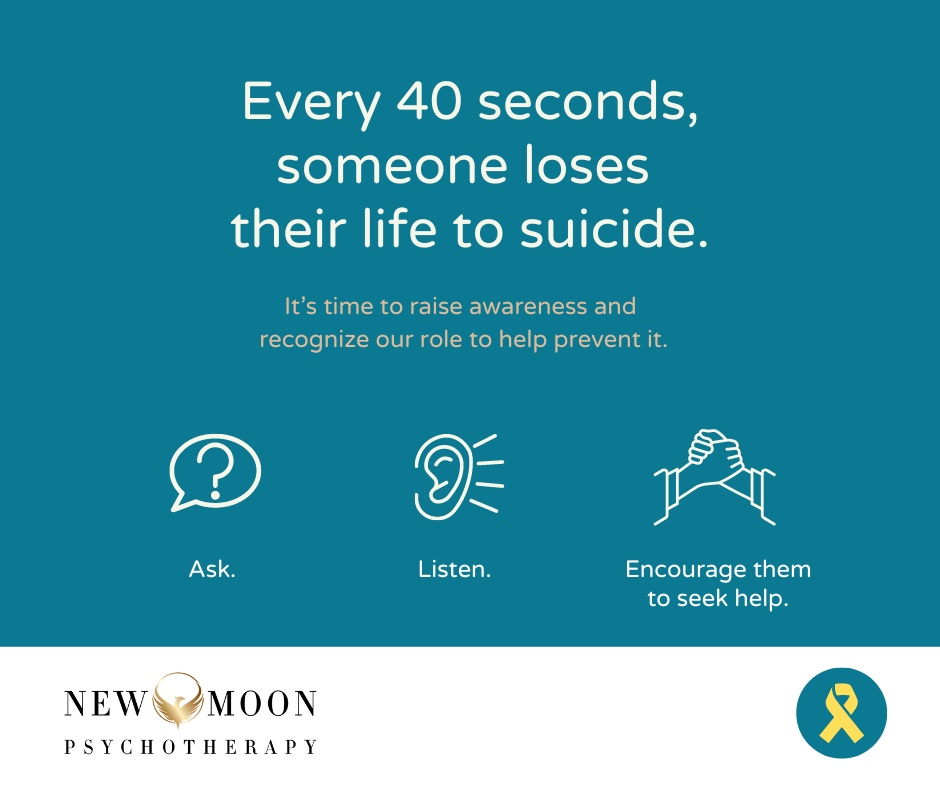September is Suicide Prevention Month

Everyone has a role in suicide prevention.
Outlined in this blog are ways that you can support suicide prevention through:
- Knowing the warning signs;
- Risk factors; and
- How to support someone in a mental health crisis
What are the warning sings?
Warning signs are things to look out for when concerned that a person may be suicidal.
- Prolonged sadness or depression: The person has been experiencing long-lasting/persistent sadness or depression.
- Personality changes: The person’s typical attitude and behaviours have shifted. This may include: aggression, irritability, fatigue, agitation, sleeping too much or too little, increased use of substances, isolating from friends and family, socially withdrawing, decreased concern about physical appearance, poor hygiene, loss of interest from what they once enjoyed, reckless/’risky’ behaviour, giving away possessions, saying goodbye, searching for methods, etc.
- They might talk about: Feeling like a burden to others, unbearable pain, feeling trapped or hopeless, having no reason to live, questioning their own existence, etc.
What are the risk factors?
Risk factors are characteristics or conditions that increase the chance that a person may try to take their life.
- Individual Risk Factors: Mental health conditions, chronic pain, terminal illness, legal/financial stressors, unemployment, substance misuse, etc.
- Relational Risk Factors: History of physical, emotional, or sexual abuse, bullying, relationship problems, break-ups/divorce, death of a loved one, socially isolated/lacks support network, etc.
- Community/Societal Risk Factors: Ashamed to ask for help (i.e. internalized stigma), has become aware of an increased number of deaths by suicide or an increase in media coverage of deaths by suicide, lacks access to health and mental health care, faces social, economic, and/or systemic oppression, etc.
What do to if you are concerned?
If you’re worried about someone in your life, remember T.A.S.C. or W.A.I.T.
T.A.S.C.
T: Tune in
Pay attention – has their behaviour changed? Are they not as talkative or engaged as they usually are? Are they saying things like, “It would be better if I wasn’t here”, or “I wish I could just die”?
A: Ask
Ask clearly and without judgement, “are you thinking about suicide?”. These are hard questions to ask, but are necessary. Remember to be open-minded and avoid saying anything that will make them feel worse, or discourage them from talking.
S: State
State that suicide is serious and let them know that you care about them.
C: Connect
Connect them to support (personal and professional). You don’t have to be the one to solve their problems, but you can urge that they access the appropriate support, and help them to do so. Stay with them to keep them safe during this time.
W.A.I.T.
W: Watch out
Watch out for signs of distress and changes in behaviour.
A: Ask
Ask them, “are you having suicidal thoughts?”, or “are you thinking about suicide?”.
I: It will pass
Validate their struggles and assure them that with help, their suicidal feelings will pass.
T: Talk to others
Encourage them to seek help and connect them to a network of supportive people (this can be friends, family, and mental health professionals).
If someone you know is at imminent risk of suicide*
If faced with a person at imminent risk of suicide, or has taken action to harm oneself, seek immediate help by calling emergency services or taking them to the nearest hospital.
While waiting for emergency services:
- Reassure them and continue to engage and communicate with them in a calm, respectful manner
- Stay with them until emergency services arrive on the scene
*Imminent risk of suicide:
- Suicide attempt in progress; or
- Has a clear intent, a detailed plan and access to lethal means, and an immediate timeframe to carry out their plan
Even if an attempt has not been made, but you have no control over the person’s safety, phone emergency services immediately.
An important note
If someone you know is exhibiting warning signs for suicide, do not be afraid to ask them if they are thinking about taking their life. Listen compassionately and without judgement. In some cases, people experiencing suicidal thoughts just need to know that someone loves and cares about them, and are willing to listen to them talk about how they’re feeling.
Resources
Talk Suicide Canada:
If you or someone you know is thinking about suicide, call Talk Suicide Canada at 1-833-456-4566 (24/7) or text 45645 (4 PM – 12 AM ET).
For residents of Québec, call 1 866 APPELLE (1-866-277-3553) (24/7) or visit suicide.ca.
Visit Talk Suicide Canada for the distress centres and crisis organizations nearest you.
Kids Help Phone:
Call 1-800-668-6868 (toll-free) or text CONNECT to 686868.
Available 24 hours a day to Canadians aged 5 to 29 who want confidential and anonymous care from professional counsellors
Download the Always There app for additional support or access the Kids Help Phone website
Hope for Wellness Help Line
Call 1-855-242-3310 (toll-free) or connect to the online Hope for Wellness chat.
Available to all Indigenous peoples across Canada who need immediate crisis intervention. Experienced and culturally sensitive help line counsellors can help if you want to talk or are distressed.
Telephone and online counselling are available in English and French. On request, telephone counselling is also available in Cree, Ojibway and Inuktitut.
Sources:
https://afsp.org/risk-factors-protective-factors-and-warning-signs
https://www.canada.ca/en/public-health/services/suicide-prevention/warning-signs.html
https://my.clevelandclinic.org/health/articles/11352-recognizing-suicidal-behavior

